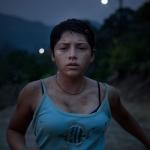‘Prayers for the Stolen’ Review: A Ferrante-Like Fable About Mexico’s Missing Girls

Mexico has witnessed over 80,000 disappearances since former President Felipe Calderon declared a war on drug cartels in 2006. A quarter of the missing are women — the majority of them teenage girls. “Prayers for the Stolen,” Mexican-Salvadorian director Tatiana Huezo’s first narrative feature, takes place amidst this national nightmare, depicting the dangers and deep-seated fears that families have long endured. Told through the lens of three girls as they grow up in a rural town in the Guerrero mountains, Huezo’s film is a murky, mesmerizing look at what it feels like to come of age in a place where young women have a target on their backs, and where the adults are as powerless as the children.
As a documentary filmmaker, Huezo has immersed herself in communities across Mexico and her native El Salvador to show the human consequences of their seemingly endless wars. In “Tempestad” (2016), she tells the story of two women exploited by the drug war in Mexico, and here she brings the same harrowing overtone of urgency to her fiction debut.
“Prayers for the Stolen” introduces us to the three eight-year-old girls as they excitedly observe insects in the forest, but this edenic prologue comes to an abrupt end — there’s a snake in the grass (literally), one that appears to be poisonous. Dangers lurk everywhere for Ana (Ana Cristina Ordóñez González, who brings a remarkable sense of maturity to her first role) and her two best friends, but it doesn’t stop them from frolicking through their threatening environment with the carefree giddiness of your average girl.
Early in the film, Ana’s mother Rita (played with a palpable sense of suffering and emotional exhaustion by Mayra Batalla) forces her to dig a hole big enough for her to fit inside of, in case she needs to hide from the cartels or the corrupt police with whom they may be collaborating. It feels like the entire village is digging its own grave; their economy is based on extracting natural resources from their fast-fading mountaintops, as well as from poppy plants, whose thick brown sap is collected to fuel the deadly drug trade.
Huezo slowly lets the story unfold, telling it through a series of small episodes that add up to a horrifying climax. We sympathize with Ana and her friends as we, too, try to piece together all the facts in an attempt to understand what’s transpiring in this village; there’s a strong air of mystery keeping the world of adults just out of reach. Like the heroines of Elena Ferrante’s novels, our characters yearn to be a part of this world, whether it’s by wearing makeup and flirting with boys, or knowing the real reasons girls are disappearing or turning up dead around them. Instead, they’re forced to cut their hair like boys (to prevent lice, their mothers say), as if to be a woman is almost a crime. It’s never spelled out, but these mothers are trying to prevent their daughters from being victims of sex trafficking by hiding any apparent signs of womanhood.
Halfway through the film, the three girls emerge as teenagers, with three different actors playing the roles. Huezo cast these six actors over the course of a year, auditioning about 800 girls from rural parts of Mexico, all of them non-actors. The girls went through professional acting training over three months and lived together for weeks. The process yields varied results. González is a remarkable talent, bringing a diverse and honest range of raw emotions to her character as she navigates the challenges that surround her. While some scenes can be over the top — a moment in which Ana diligently sweeps up a glass her mother drunkenly throws at the wall feels like it’s milking viewers for sympathy — González maintains an air of subtlety, allowing her stunned and concerned expression to convey more than any overblown theatrics can.
Meanwhile, Huezo’s commitment to keeping the girls’ looks consistent as they age is admirable, but it’s ultimately a distracting choice that feels forced and unnecessary, as if finding a girl who resembled young Ana was more important than finding the best possible actor. The director went so far as to create a latex map over the older Ana’s face (Marya Membreño) to match González’s moles and freckles, which gives her a sort of CGI-quality that takes away from the grit of the filmic environment. Choosing to represent actors at different stages can often be awkward, but attempting to conceal those differences is arguably worse.
Huezo’s film is at its best when it periodically lands on a striking visual image that encapsulate the community without words: a sea of cell phone screens aglow on a mountain at dusk as the women of the town try to find service to contact their families, including Ana’s father in America (he never sends money or answers the phone). Or the outline of a body squirming under a fitted sheet tucked tightly into a bed in a room bathed in pink light, a place to conceal oneself during a game of hide-and-seek. Director of photography Dariela Ludlow captures the complexity of these moments with sensitivity, painting a picture of a community on its last legs.
“Prayers for the Stolen” shines a much-needed light on the consequences of Mexico’s war on drugs, specifically highlighting the plight of the nation’s women and girls. While she would have benefitted from maintaining some more of the naturalism of her documentary work in lieu of the special effects and makeup tricks of the narrative film world, her first foray into fiction is a forceful look into a part of Mexico that’s perhaps best understood through young girls’ eyes, where the greatest threats are lurking within the questions their parents refuse to answer.
“Prayers for the Stolen” screened at the 2021 New York Film Festival. It is now available to stream on Netflix.
